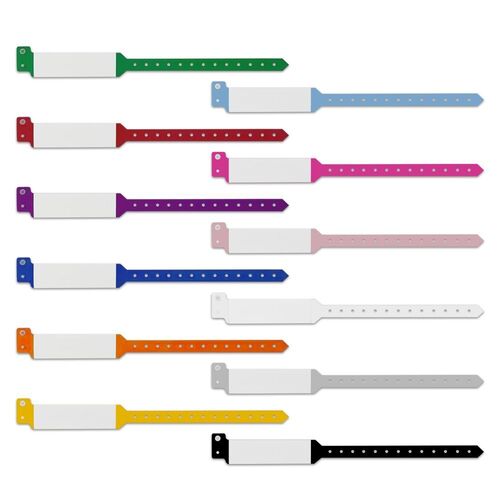Checking Out the Numerous Types of Patient Identification Band Utilized in Medical Facilities
In the complex world of healthcare, the critical duty of Patient Identification bands typically goes undetected. These bands, varying from easy paper wristbands to advanced RFID bands, develop the foundation of Patient safety protocols, making sure accuracy in Patient Identification. Yet, the vast diversity of these bands, each with its special benefits and restrictions, is commonly neglected. As we navigate with this subject, one might acquire understanding into the refined intricacies and vital value of such bands in clinical facilities.
Recognizing the Importance of Patient Identification Bands
While they might seem like simple devices, Patient Identification bands play a crucial function in medical centers. These bands function as a critical device for verifying Patient identity, preventing clinical mistakes related to misidentification. The bands usually show vital details such as the Patient's name, age, blood group, and any kind of recognized allergic reactions. They allow medical care experts to swiftly access this critical info, thereby promoting punctual and accurate clinical therapy. Patient Identification bands likewise aid in enhancing management tasks, making sure precise record-keeping and billing. In spite of their simplicity, these bands symbolize the concept of Patient security, a foundation of top quality healthcare. Without them, the risk of medical errors, and as a result, Patient harm, may significantly raise.
Standard Paper Wristbands: Their Use and Limitations
Typical paper wristbands have been a staple in Patient Identification across different medical centers. While their use is extensive, they nurture specific constraints that may impact their effectiveness in Patient administration. This section will certainly focus on the range of their application and the integral disadvantages related to their usage.
Paper Wristbands: Usage Extent
In the realm of Patient Identification, paper wristbands have long held a critical function. These bands are commonly used in outpatient setups, where the Patient's stay is momentary. Despite innovations in modern technology, the humble paper wristband stays a dependable and cost-efficient service for Patient Identification in various medical care circumstances.
Limitations of Paper Wristbands
Regardless of their widespread usage, paper wristbands are not without their downsides. In enhancement, paper wristbands usually do not have the technical capabilities of even more modern-day alternatives, such as barcoding or RFID chips, restricting their performance to merely showing composed information. Paper wristbands can cause discomfort or skin inflammation to some clients, specifically when used for extensive periods.
Barcoded Wristbands: Advancements in Patient Identification
While Patient Identification has actually long been an important element of medical care, the advent of barcoded wristbands represents a significant jump onward. These bands utilize the simpleness of barcoding innovation, enabling for Patient details to be swiftly scanned and accessed. They enhance the speed and accuracy of Patient Identification, decreasing the threat of clinical mistakes associated to misidentification.
Superhigh Frequency Identification (RFID) Bands: a Step In The Direction Of Futuristic Medical Care
The development of Patient Identification bands has produced the development of Radio Regularity Identification (RFID) Bands (patient identification band). These innovative tools existing essential advantages for medical care centers, offering an extra efficient and Web Site highly advanced means of Patient Identification. The implementation of RFID in health care is a substantial action towards a more advanced approach to Patient monitoring and safety and security
Understanding RFID Bands

RFID Bands: Trick Benefits
Primarily, these bands boost Patient safety and security by providing precise, rapid Identification, thus reducing medical errors. RFID bands can keep a huge amount of Patient information, including clinical background and allergies, allowing customized care. Generally, RFID bands stand for a significant improvement in Patient Identification innovation, profiting both patients and medical care providers.
Executing RFID in Healthcare
These bands give a seamless method to track and identify patients, guaranteeing their safety and security and improving effectiveness in therapy procedures. RFID bands decrease medical mistakes by providing precise Patient Identification, which is important in avoiding misdiagnosis or wrong medicine management. Hence, the application of RFID bands is a substantial action in the direction of enhancing Patient safety and security and healthcare delivery.

Color-Coded Wristbands: Aiding in Quick and Accurate Diagnosis
In the busy setting of a clinical facility, color-coded wristbands have actually emerged as important tools for swift and specific Identification of a client's medical condition. These wristbands, worn by people, bring details shades that match to various medical problems informative post or statuses. This system is developed to supply instant visual hints to healthcare carriers, enhancing Patient safety and care high quality.
Methods for Effective Application and Monitoring of Patient ID Bands
Accomplishing optimal use of Patient Identification bands requires a well-structured technique for their implementation and administration. Patient education and learning is additionally vital; patients should recognize the function of the bands and the requirement for their consistent wear. It's important to have a back-up plan in place, such as barcode scanning or biometrics, to guarantee that Patient Identification is never endangered.
Verdict
Patient Identification bands are important in medical facilities to guarantee security and precision. Efficient implementation and monitoring of these bands can significantly lower medical mistakes, increase efficiency, and enhance overall Patient care.
These bands, differing from straightforward paper wristbands to innovative RFID bands, develop the backbone of Patient safety protocols, guaranteeing accuracy in Patient Identification.The development of Patient Identification bands has actually brought about the development of Radio Frequency Identification (RFID) Bands. In general, RFID bands stand for a significant advancement in Patient Identification innovation, benefiting both individuals and healthcare providers.
RFID bands reduce medical mistakes by giving exact Patient Identification, which is important in protecting against misdiagnosis or wrong medicine administration. Patient education is also vital; clients must comprehend Visit Your URL the purpose of the bands and the need for their constant wear.